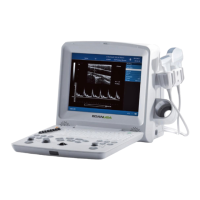DUS 60 Digital Ultrasonic Diagnostic Imaging System User Manual Introduction
- 2 -
It is recommended not to examine the parts with wounds or acute inflammation to avoid
cross infection.
1.5. General Safety Precaution Information
1.5.1. General Information
WARNING
This equipment is not intended for treatment.
CAUTION
1. Federal (U.S.) law restricts this device to sale by or on the order of a physician.
2. The pictures and interfaces in this manual are for reference only.
NOTE: This equipment is not intended for home use.
The reliability of the device and the safety of operators and patients are considered during
product design and production. The following safety and preventive measures should be carried
out:
WARNING
1. The device should be operated by qualified operators or under their instructions.
2. The device should be operated appropriately to avoid mechanical damage to the
transducer.
3. Do not alter parameters of the device at will. If it is necessary, please consult EDAN
or authorized representatives for service.
4. The device has already been adjusted to its optimum performance. Do not adjust any
presetting control or switch, unless it is listed in this manual.
5. If the device breaks down, please shut down the machine immediately and contact
EDAN or authorized representatives.
6. Only accessories supplied or recommended by EDAN can be used, the battery and
probes of EDAN can be only used on EDAN’s systems. Otherwise, the performance
and electric shock protection can not be guaranteed. If electrical or mechanical
equipment from other companies need to be connected to the device, please contact
EDAN or authorized representatives before connection.
7. EXPLOSION HAZARD-Equipment is not suitable for use in the presence of a
flammable anesthetic mixture with air or with oxygen or nitrous oxide.
DUS 60 Digital Ultrasonic Diagnostic Imaging System User Manual Introduction
- 3 -
WARNING
8. If the liquid crystal material leaks from the panel, it should be kept away from the eye
or mouth. In case of contact with hands, skin or clothes, it has to be washed away
thoroughly with soap.
1.5.2. Biohazard Considerations
WARNING
1. This device is not suitable for intracardiac use or direct cardiac contact.
2. For neonatal head imaging, EDAN recommends that you exercise special care
during neonatal cephalic scanning to avoid possible damage to the posterior region
of the eye. The ultrasound energy emitted by the probe easily penetrates the
fontanels of the infant.
3. EDAN makes every effort to manufacture safe and effective probes. You must take all
necessary precautions to eliminate the possibility of exposing patients, operators, or
third parties to hazardous or infectious materials. These precautions should be
considered in the use of any application that may indicate the need for such care, and
during endocavity scanning.
Ultrasound may be harmful to human body. This device should be used for valid reasons,
for the shortest period of time, and at the lowest mechanical and thermal indices necessary to
produce clinically acceptable images. According to the ALARA (As Low As Reasonably
Achievable) principles, acoustic output should be set to the lowest level required to satisfactorily
perform the examination. Long time exposure should be avoided. For the parameters of sound
output, please refer to appendix II.
The DUS 60 complies with the requirements of applicable International Electrotechnical
Commission (IEC) standards in terms of safety and acoustic output levels.
1.5.3. Electrical Safety
WARNING
1. If you have any questions about the grounding connection, use the battery but not
the AC power supply.
2. To ensure grounding reliability, only connect the system to a hospital-grade power
receptacle.
WARNING

